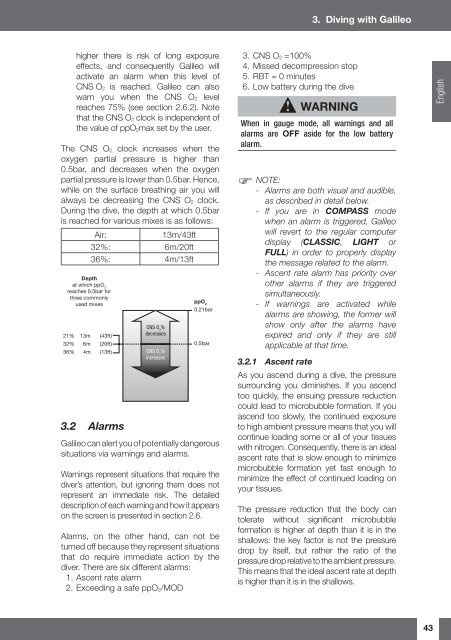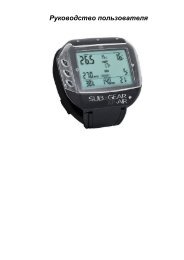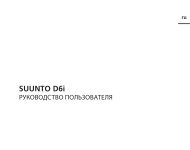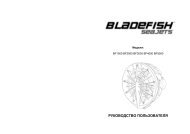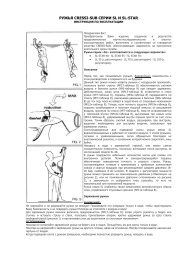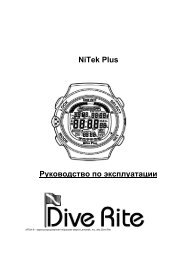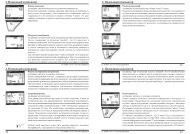Galileo SOL Manual - Scubapro
Galileo SOL Manual - Scubapro
Galileo SOL Manual - Scubapro
You also want an ePaper? Increase the reach of your titles
YUMPU automatically turns print PDFs into web optimized ePapers that Google loves.
3. Diving with <strong>Galileo</strong><br />
higher there is risk of long exposure<br />
effects, and consequently <strong>Galileo</strong> will<br />
activate an alarm when this level of<br />
CNS O 2 is reached. <strong>Galileo</strong> can also<br />
warn you when the CNS O 2 level<br />
reaches 75% (see section 2.6.2). Note<br />
that the CNS O 2 clock is independent of<br />
the value of ppO 2max set by the user.<br />
The CNS O 2 clock increases when the<br />
oxygen partial pressure is higher than<br />
0.5bar, and decreases when the oxygen<br />
partial pressure is lower than 0.5bar. Hence,<br />
while on the surface breathing air you will<br />
always be decreasing the CNS O 2 clock.<br />
During the dive, the depth at which 0.5bar<br />
is reached for various mixes is as follows:<br />
Air:<br />
13m/43ft<br />
32%: 6m/20ft<br />
36%: 4m/13ft<br />
Depth<br />
at which ppO 2<br />
reaches 0.5bar for<br />
three commonly<br />
used mixes<br />
21% 13m (43ft)<br />
32% 6m (20ft)<br />
36% 4m (13ft)<br />
3.2 Alarms<br />
CNS O 2<br />
%<br />
decreases<br />
CNS O 2<br />
%<br />
increases<br />
ppO 2<br />
0.21bar<br />
0.5bar<br />
<strong>Galileo</strong> can alert you of potentially dangerous<br />
situations via warnings and alarms.<br />
Warnings represent situations that require the<br />
diver’s attention, but ignoring them does not<br />
represent an immediate risk. The detailed<br />
description of each warning and how it appears<br />
on the screen is presented in section 2.6.<br />
Alarms, on the other hand, can not be<br />
turned off because they represent situations<br />
that do require immediate action by the<br />
diver. There are six different alarms:<br />
1. Ascent rate alarm<br />
2. Exceeding a safe ppO 2/MOD<br />
3. CNS O 2 =100%<br />
4. Missed decompression stop<br />
5. RBT = 0 minutes<br />
6. Low battery during the dive<br />
WARNING<br />
When in gauge mode, all warnings and all<br />
alarms are OFF aside for the low battery<br />
alarm.<br />
NOTE:<br />
- Alarms are both visual and audible,<br />
as described in detail below.<br />
- If you are in COMPASS mode<br />
when an alarm is triggered, <strong>Galileo</strong><br />
will revert to the regular computer<br />
display (CLASSIC, LIGHT or<br />
FULL) in order to properly display<br />
the message related to the alarm.<br />
- Ascent rate alarm has priority over<br />
other alarms if they are triggered<br />
simultaneously.<br />
- If warnings are activated while<br />
alarms are showing, the former will<br />
show only after the alarms have<br />
expired and only if they are still<br />
applicable at that time.<br />
3.2.1 Ascent rate<br />
As you ascend during a dive, the pressure<br />
surrounding you diminishes. If you ascend<br />
too quickly, the ensuing pressure reduction<br />
could lead to microbubble formation. If you<br />
ascend too slowly, the continued exposure<br />
to high ambient pressure means that you will<br />
continue loading some or all of your tissues<br />
with nitrogen. Consequently, there is an ideal<br />
ascent rate that is slow enough to minimize<br />
microbubble formation yet fast enough to<br />
minimize the effect of continued loading on<br />
your tissues.<br />
The pressure reduction that the body can<br />
tolerate without signifi cant microbubble<br />
formation is higher at depth than it is in the<br />
shallows: the key factor is not the pressure<br />
drop by itself, but rather the ratio of the<br />
pressure drop relative to the ambient pressure.<br />
This means that the ideal ascent rate at depth<br />
is higher than it is in the shallows.<br />
English<br />
43


